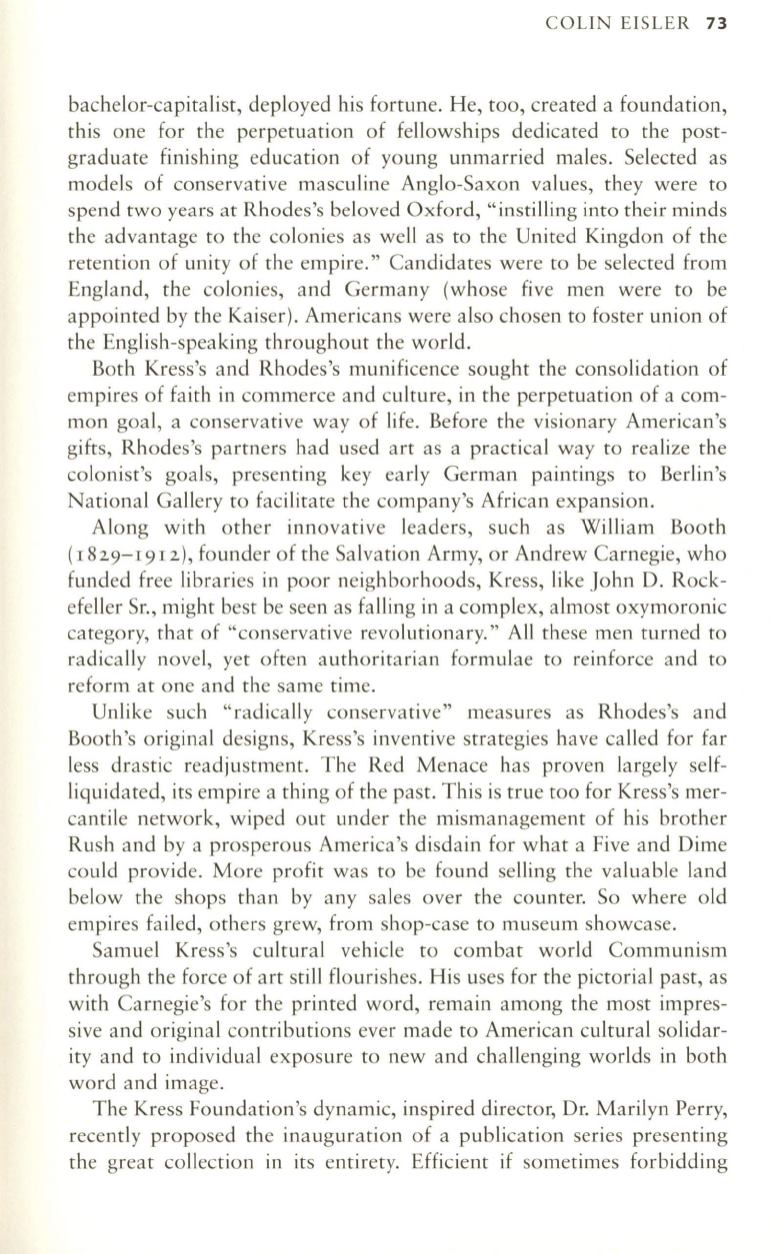
COLIN EISLER 73
bachelor-capitalist, deployed his fortune . He, too, created a foundation,
this one for the perpetuation of fellowships dedicated to the post–
graduate finishing education of young unmarried males. Selected as
models of conservative masculine Anglo-Saxon values, they were to
spend two years at Rhodes's beloved Oxford, "instilling into their minds
the advantage to the colonies as well as to the United Kingdon of the
retention of unity of the empire." Candidates were to be selected from
England, the colonies, and Germany (whose five men were to be
appointed by the Kaiser). Americans were also chosen to foster union of
the English-speaking throughout the world.
Both Kress's and Rhodes's munificence sought the consolidation of
empires of faith in commerce and culture, in the perpetuation of a com–
mon goal, a conservative way of life. Before the visionary American's
gifts, Rhodes's partners had used art as a practical way to realize the
colonist's goals, presenting key early German paintings to Berlin's
National Gallery to facilitate the company's African expansion.
Along with other innovative leaders, such as William Booth
(1829-1912),
founder of the Salvation Army, or Andrew Carnegie, who
funded free libraries in poor neighborhoods, Kress, like John D. Rock–
efeller Sr., might best be seen as falling in a complex, almost oxymoronic
category, that of "conservative revolutionary." All these men turned to
radically novel, yet often authoritarian formulae to reinforce and to
reform at one and the same time.
Unlike such "radically conservative" measures as Rhodes's and
Booth's original designs, Kress's inventive strategies have called for far
less drastic readjustment. The Red Menace has proven largely self–
liquidated, its empire a thing of the past. This is true too for Kress's mer–
cantile network, wiped out under the mismanagement of his brother
Rush and by a prosperous America's disdain for what a Five and Dime
could provide. More profit was to be found selling the valuable land
below the shops than by any sales over the counter. So where old
empires failed, others grew, from shop-case to museum showcase.
Samuel Kress's cultural vehicle to combat world Communism
through the force of art still flourishes . His uses for the pictorial past, as
with Carnegie's for the printed word, remain among the most impres–
sive and original contributions ever made to American cultural solidar–
ity and to individual exposure to new and challenging worlds in both
word and image.
The Kress Foundation's dynamic, inspired director, Dr. Marilyn Perry,
recently proposed the inauguration of a publication series presenting
the great collection in its entirety. Efficient if sometimes forbidding


